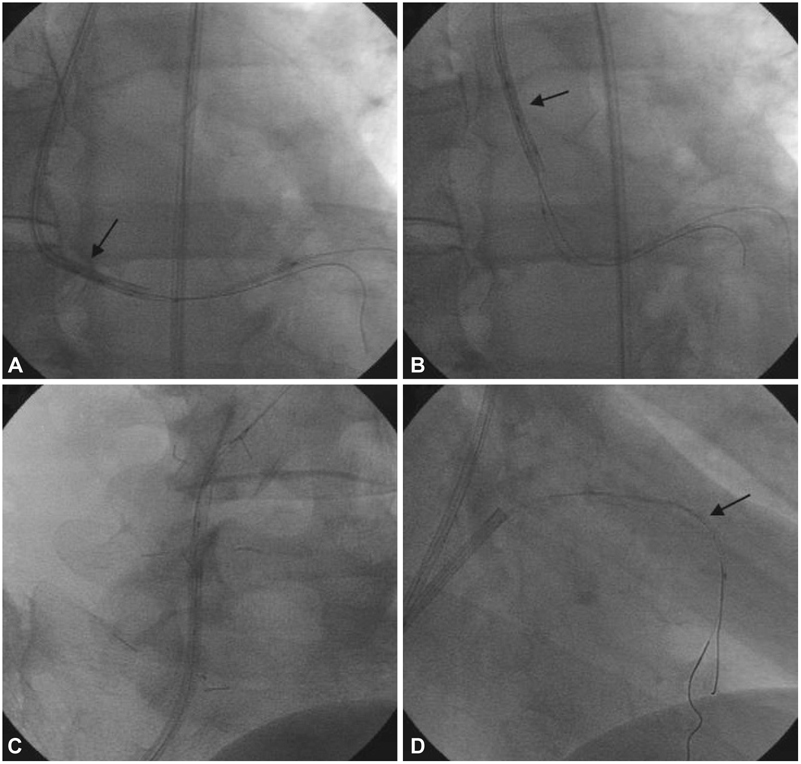Korean Circ J.
2010 Aug;40(8):405-409. 10.4070/kcj.2010.40.8.405.
A Novel Technique for Retrieval of a Drug-Eluting Stent After Catheter Break and Stent Loss
- Affiliations
-
- 1Cardiovascular Center, Korea University Guro Hospital, Seoul, Korea. swrha617@yahoo.co.kr
- 2Division of Cardiology, Department of Internal Medicine, Eulji Medical Center, Seoul, Korea.
- KMID: 2145533
- DOI: http://doi.org/10.4070/kcj.2010.40.8.405
Abstract
- Break of a stent delivery catheter and subsequent stent loss (SL) has been a rare event in the drug-eluting stent (DES) era. We here report a case of successful retrieval of a stent after a break if the delivery catheter and SL from a balloon catheter at a culprit lesion. We finally resolved this situation using a simple balloon technique for both the broken stent catheter inside of the guide catheter and the unexpanded stent in the culprit lesion. Thus balloons are an important weapon in our armamentarium in the cardiac catheterization laboratory for urgent retrieval of a lost stent. Their apt use definitely allowed our patient to avoid undergoing emergency cardiovascular thoracic surgery.
Keyword
MeSH Terms
Figure
Reference
-
1. Hur JM, Jeon JI, Jo KG, Choi JW, Moon CH. Two cases of non surgical removal of intravascular foreign bodies. Korean Circ J. 1997. 27:922–926.2. Eggebrecht H, Haude M, von Birgelen C, et al. Nonsurgical retrieval of embolized coronary stents. Catheter Cardiovasc Interv. 2000. 51:432–440.3. Brilakis ES, Best PJ, Elesber AA, et al. Incidence, retrieval methods, and outcomes of stent loss during percutaneous coronary intervention: a large single-center experience. Catheter Cardiovasc Interv. 2005. 66:333–340.4. Fujita S, Tamai H, Kyo E, et al. New technique for superior guiding catheter support during advancement of a balloon in coronary angioplasty: the anchor technique. Catheter Cardiovasc Interv. 2003. 59:482–488.5. Trehan V, Mukhopadhyay S, Yusuf J, C Ramgasetty U, Mukherjee S, Arora R. Intracoronary fracture and embolization of a coronary angioplasty balloon catheter: retrieval by a simple technique. Catheter Cardiovasc Interv. 2003. 58:473–477.6. Foster-Smith KW, Garratt KN, Higano ST, Holmes DR Jr. Retrieval techniques for managing flexible intracoronary stent misplacement. Cathet Cardiovasc Diagn. 1993. 30:63–68.7. Eeckhout E, Stauffer JC, Goy JJ. Retrieval of a migrated coronary stent by means of an alligator forceps catheter. Cathet Cardiovasc Diagn. 1993. 30:166–168.8. Kim MH, Cha KS, Kim JS. Retrieval of dislodged and disfigured transradially delivered coronary stent: report on a case using forcep and antegrade brachial sheath insertion. Catheter Cardiovasc Interv. 2001. 52:489–491.9. Berder V, Bedossa M, Gras D, Paillard F, Le Breton H, Pony JC. Retrieval of a lost coronary stent from the descending aorta using a PTCA balloon and biopsy forceps. Cathet Cardiovasc Diagn. 1993. 28:351–353.
- Full Text Links
- Actions
-
Cited
- CITED
-
- Close
- Share
- Similar articles
-
- Drug-Eluting Stent Strut Fracture as a Cause of Restenosis
- Percutaneous Treatment of an Injured Coronary Stent Using the Looping Wire Technique
- Very Late Stent Thrombosis Related to Fracture of a Sirolimus-Eluting Stent
- A Case of Stent Strut Fracture of a Paclitaxel-Eluting Stent at the Time of Stent Implantation in a Complex Coronary Lesion
- Late Stent Thrombosis Associated with Late Stent Malapposition after Drug-Eluting Stenting: A Case Report




